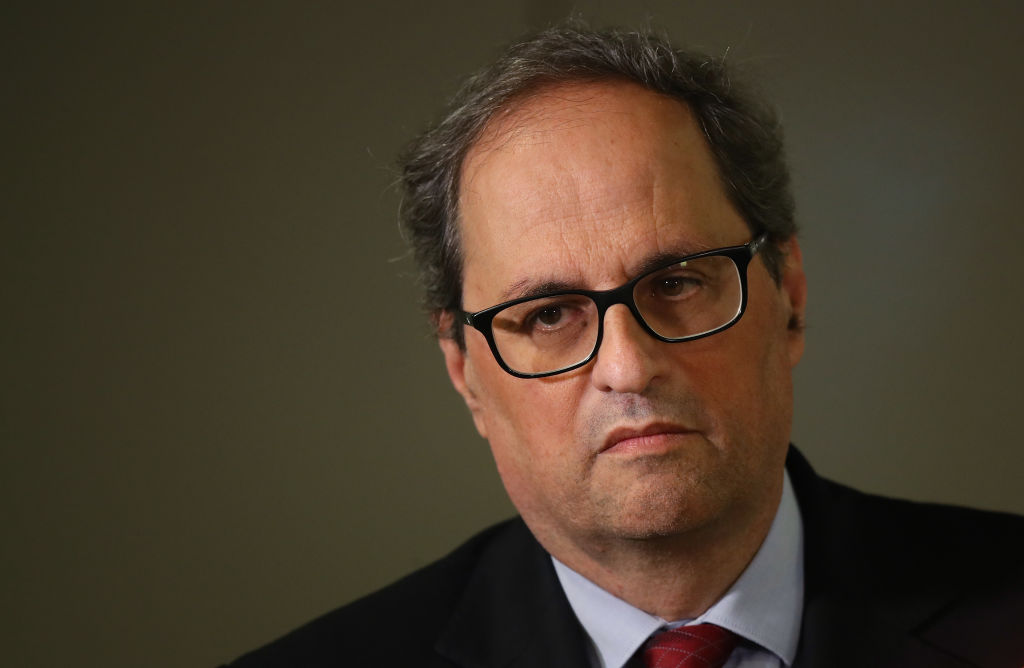After almost five months without a government, Catalonia finally has a new leader. Quim Torra won a second-round investiture vote this week to take the helm of the region’s separatist government. Unfortunately for Spanish prime minister, Mariano Rajoy, Torra’s pledge is the same as his exiled predecessor’s: to pursue an independent Catalonia. The Catalan secessionists are back.
Yet Torra’s appointment also raises problems for the pro-independence movement. He nurses an apparently visceral hatred for Spain, which sullies a cause that likes to describe itself as “progressive”. The man now leading the secessionist charge has described Spaniards as “scavengers, vipers and hyenas”. He has also said that speaking Castilian Spanish in Catalonia is not “natural”. Now in power, Torra has said sorry for these remarks, claiming that they were taken out of context. But it seems unlikely he has changed his views.
Torra was put forward by Carles Puigdemont, the former Catalan president who orchestrated last October’s shambolic independence referendum. Puigdemont is currently battling extradition from Germany on charges related to the vote, in which 92 per cent backed the option of splitting from Spain. And in some ways Torra, who has called himself a “caretaker” president, is something of a stand-in leader. Despite Puigdemont’s current troubles, Catalan separatists have made two unsuccessful attempts to reinstate him since last December: both were blocked by Spanish courts. So, Torra, being neither in prison nor exile, is the best option for the secessionists at the moment.
So what should Rajoy’s next step be? The heavy-handed response to last year’s referendum, in which hundreds were injured, didn’t look good for the Spanish government, and a second crackdown would be a mistake. Perhaps, then, Rajoy’s government could look to two former British prime ministers for tips on how to deal with Torra. That was the guidance offered by a newspaper in Spain this week, that suggested Rajoy could use a Chamberlain-style policy of appeasement towards the new secessionist leader, perhaps showing a desire for dialogue and an openness to concession; or, on the other hand, a Churchillian firmness to the new separatist movement might be a better bet.
Rajoy’s initial response has been a mixture of both approaches. Significantly, the first thing Torra did as the new Catalan president was to fly to Berlin to meet with Puigdemont, from where he requested an urgent meeting with Rajoy. Rajoy agreed but made clear that his government will never allow Catalonia to secede from Spain, thus employing a well-judged blend of diplomacy and firmness.
Torra’s appointment means that Madrid’s control of the region is now lifted (it was imposed after Puigdemont’s unilateral declaration of independence last October); but Rajoy has said the region’s finances will still be monitored to ensure that another independence referendum is not organised. Torra, of course, opposes the Spanish government’s continued vigilance of Catalonia: “we won’t accept these conditions”, he said. Already, battle lines are being drawn.
Due to the chaos triggered by last October’s independence referendum, the secessionists under Torra hardly have any room for manoeuvre. Rajoy has stated that the imposition of direct rule on Catalonia last autumn, which invoked a previously unused clause of the Spanish constitution, set a precedent; he said that he won’t hesitate to do the same thing again “if necessary”. This is a warning to Torra: don’t pursue the secessionist project any further.
How the new Catalan president responds to Rajoy’s zero-policy stance on an independent Catalonia remains to be seen. One thing is certain, though: Torra, taking succour from his embattled predecessor, is not about to let the secessionist cause die on its feet.






Comments